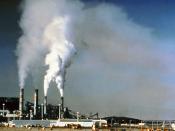"Acid Rain," or more precisely acidic precipitation, is the term used to describe
rainfall that has a pH level of less than 5.6--a pH of 7 being neutral. This form of air
pollution is currently a subject of great controversy because of the damage it does tot he environment and property worldwide. For the last ten years, this occurrence has brought destruction to thousands of lakes and streams in the United States, Canada, and parts of Europe. It also leads to the deterioration of buildings and statues by reacting with several minerals. Acid rain is formed when oxides of nitrogen and sulfite combine with moisture in the atmosphere to make nitric and sulfuric acids. These acids can be carried away far from its origin. The two primary sources of acid rain are sulfur dioxide (SO2), and oxides of nitrogen (NOx). Sulfur dioxide is a colorless gas released as a by-product of combusted fossil fuels containing sulfur.
A variety of industrial processes, such as the production of iron and steel, utility factories, and crude oil processing produce this gas. Sulfur dioxide can also be emitted into the atmosphere by natural disasters or means. This accounts for ten percent of all sulfur dioxide emission, coming from volcanoes, sea spray, plankton, and rotting vegetation. Overall, 69.4 percent of sulfur dioxide is produced by industrial combustion. Only 3.7 percent is caused by transportation . The other chemical that is also chiefly responsible for the make-up of acid rain is nitrogen oxide. Oxides of nitrogen is a term used to describe any compound of nitrogen with any amount of oxygen atoms. Nitrogen monoxide and nitrogen dioxide are all oxides of nitrogen. These gases are by-products of firing processes of extreme high temperatures (automobiles, utility plants), and in chemical industries (fertilizer production). Natural processes...


